Analysis of Funds and Reporting for Corporate Accounting (HA2032)
VerifiedAdded on 2022/10/15
|17
|3557
|9
Report
AI Summary
This report provides a comprehensive analysis of corporate and financial accounting, focusing on the sources of funds utilized by two ASX-listed companies: Investec Australia Property Fund and Carsales. The report examines the equity and liabilities of both companies, including contributed equity, retained earnings, reserves, and non-controlling interests, over a three-year period. It details the movement of these items and discusses the advantages and disadvantages of each source of fund. Furthermore, the report delves into the classification of proprietary companies (large, small, and reporting entities) and their respective compliance and reporting requirements under Australian law. The analysis is based on the companies' annual reports, providing insights into their financial strategies and reporting practices.
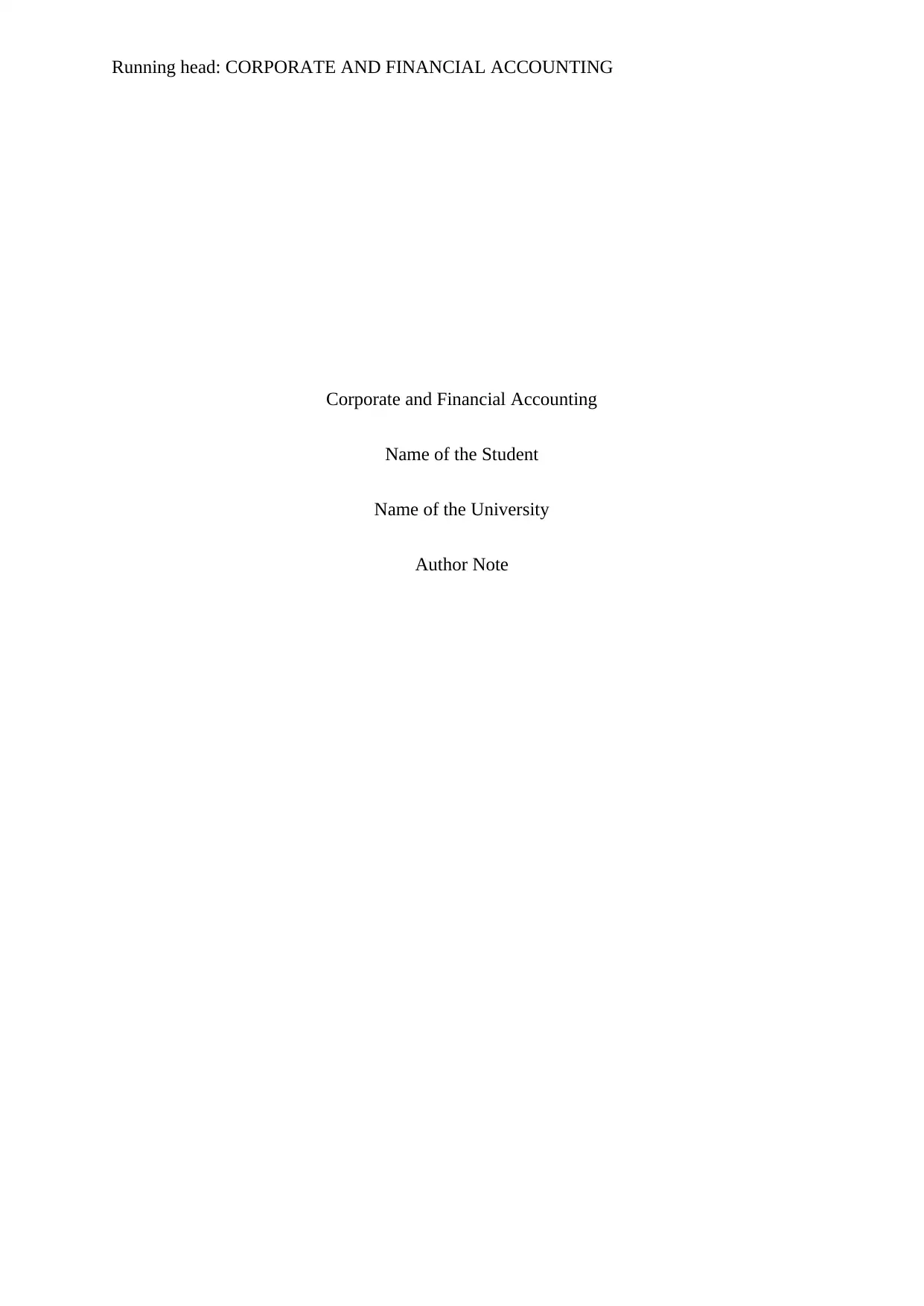
Running head: CORPORATE AND FINANCIAL ACCOUNTING
Corporate and Financial Accounting
Name of the Student
Name of the University
Author Note
Corporate and Financial Accounting
Name of the Student
Name of the University
Author Note
Paraphrase This Document
Need a fresh take? Get an instant paraphrase of this document with our AI Paraphraser
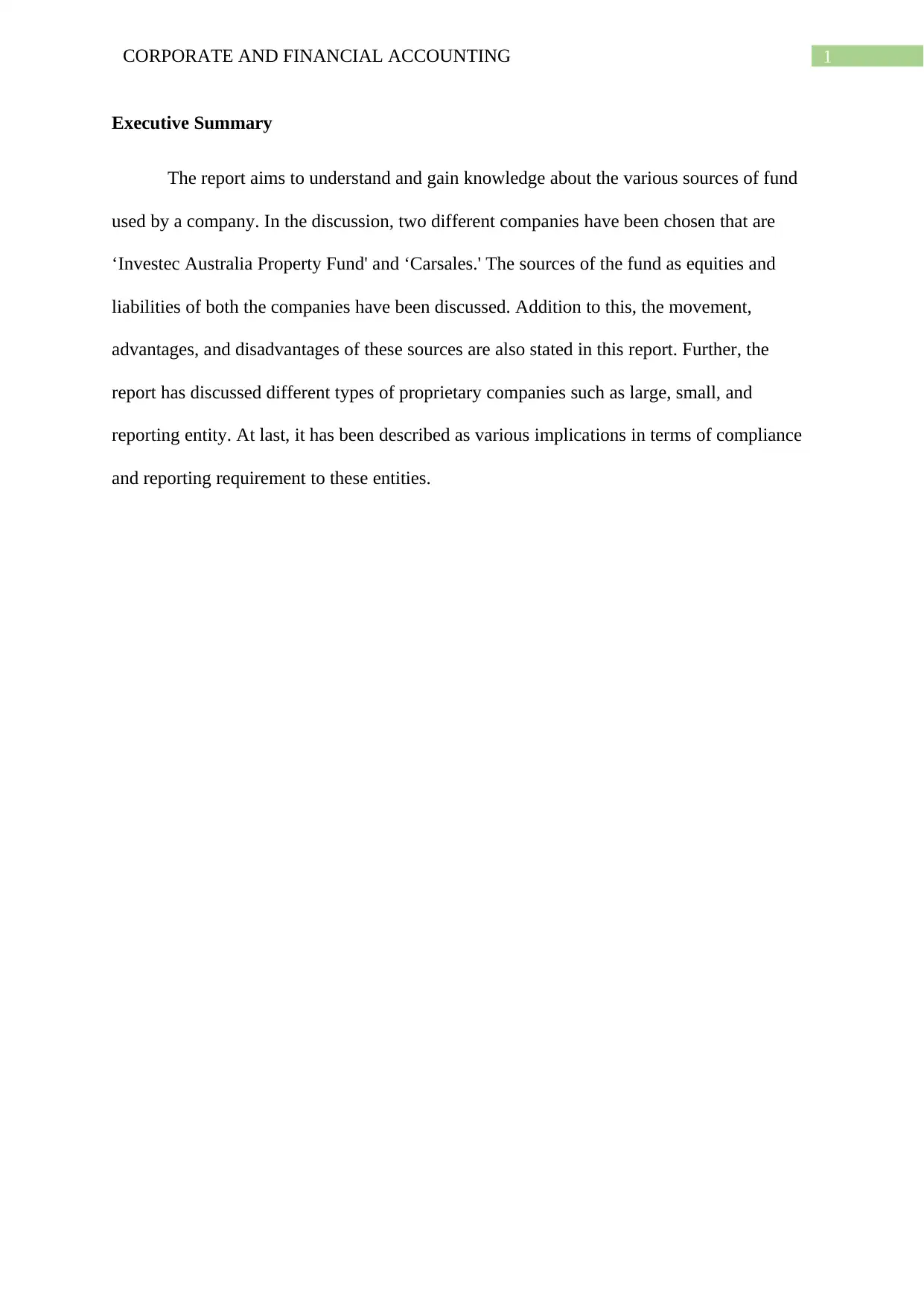
1CORPORATE AND FINANCIAL ACCOUNTING
Executive Summary
The report aims to understand and gain knowledge about the various sources of fund
used by a company. In the discussion, two different companies have been chosen that are
‘Investec Australia Property Fund' and ‘Carsales.' The sources of the fund as equities and
liabilities of both the companies have been discussed. Addition to this, the movement,
advantages, and disadvantages of these sources are also stated in this report. Further, the
report has discussed different types of proprietary companies such as large, small, and
reporting entity. At last, it has been described as various implications in terms of compliance
and reporting requirement to these entities.
Executive Summary
The report aims to understand and gain knowledge about the various sources of fund
used by a company. In the discussion, two different companies have been chosen that are
‘Investec Australia Property Fund' and ‘Carsales.' The sources of the fund as equities and
liabilities of both the companies have been discussed. Addition to this, the movement,
advantages, and disadvantages of these sources are also stated in this report. Further, the
report has discussed different types of proprietary companies such as large, small, and
reporting entity. At last, it has been described as various implications in terms of compliance
and reporting requirement to these entities.
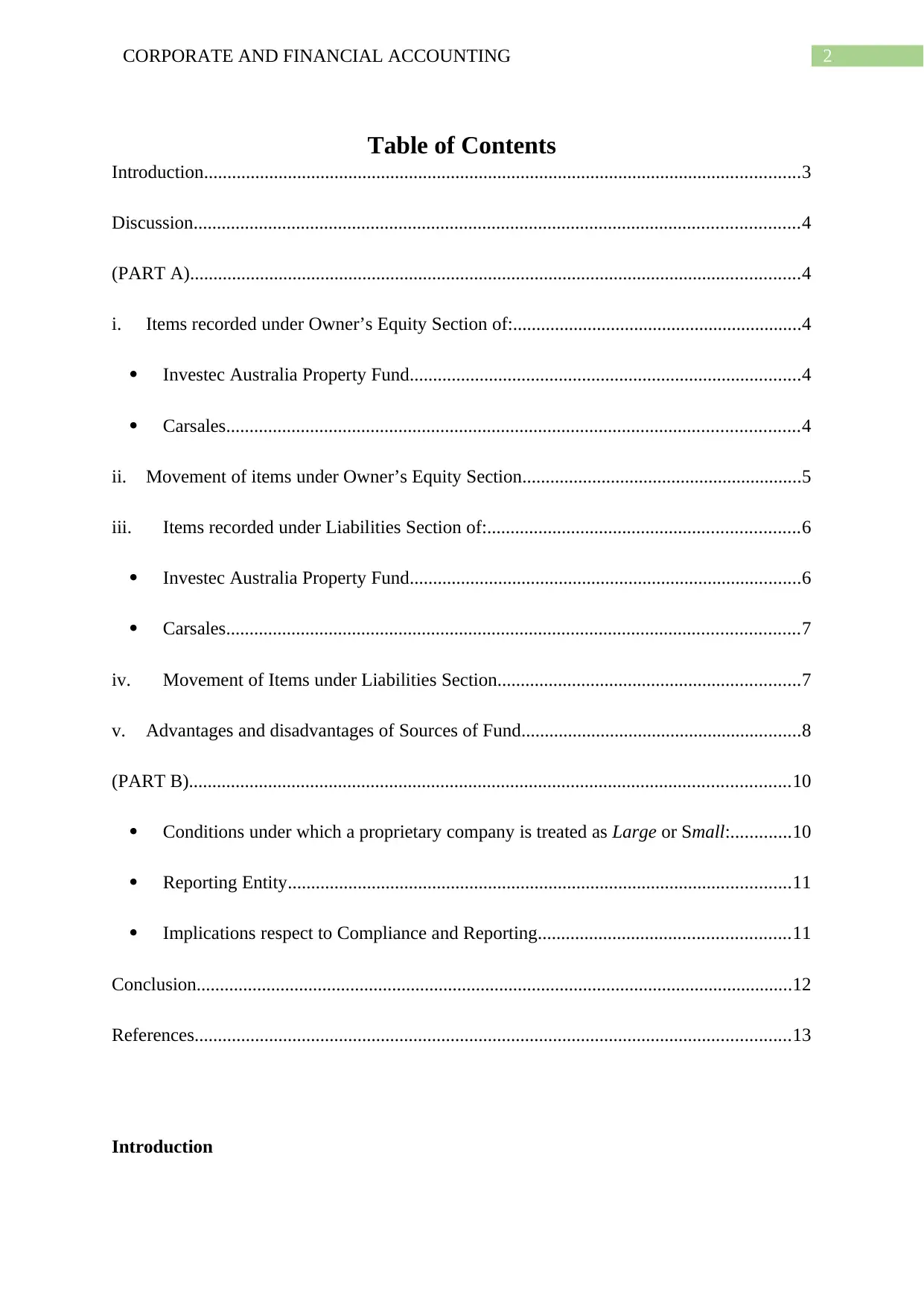
2CORPORATE AND FINANCIAL ACCOUNTING
Table of Contents
Introduction................................................................................................................................3
Discussion..................................................................................................................................4
(PART A)...................................................................................................................................4
i. Items recorded under Owner’s Equity Section of:..............................................................4
Investec Australia Property Fund....................................................................................4
Carsales...........................................................................................................................4
ii. Movement of items under Owner’s Equity Section............................................................5
iii. Items recorded under Liabilities Section of:...................................................................6
Investec Australia Property Fund....................................................................................6
Carsales...........................................................................................................................7
iv. Movement of Items under Liabilities Section.................................................................7
v. Advantages and disadvantages of Sources of Fund............................................................8
(PART B).................................................................................................................................10
Conditions under which a proprietary company is treated as Large or Small:.............10
Reporting Entity............................................................................................................11
Implications respect to Compliance and Reporting......................................................11
Conclusion................................................................................................................................12
References................................................................................................................................13
Introduction
Table of Contents
Introduction................................................................................................................................3
Discussion..................................................................................................................................4
(PART A)...................................................................................................................................4
i. Items recorded under Owner’s Equity Section of:..............................................................4
Investec Australia Property Fund....................................................................................4
Carsales...........................................................................................................................4
ii. Movement of items under Owner’s Equity Section............................................................5
iii. Items recorded under Liabilities Section of:...................................................................6
Investec Australia Property Fund....................................................................................6
Carsales...........................................................................................................................7
iv. Movement of Items under Liabilities Section.................................................................7
v. Advantages and disadvantages of Sources of Fund............................................................8
(PART B).................................................................................................................................10
Conditions under which a proprietary company is treated as Large or Small:.............10
Reporting Entity............................................................................................................11
Implications respect to Compliance and Reporting......................................................11
Conclusion................................................................................................................................12
References................................................................................................................................13
Introduction
⊘ This is a preview!⊘
Do you want full access?
Subscribe today to unlock all pages.

Trusted by 1+ million students worldwide
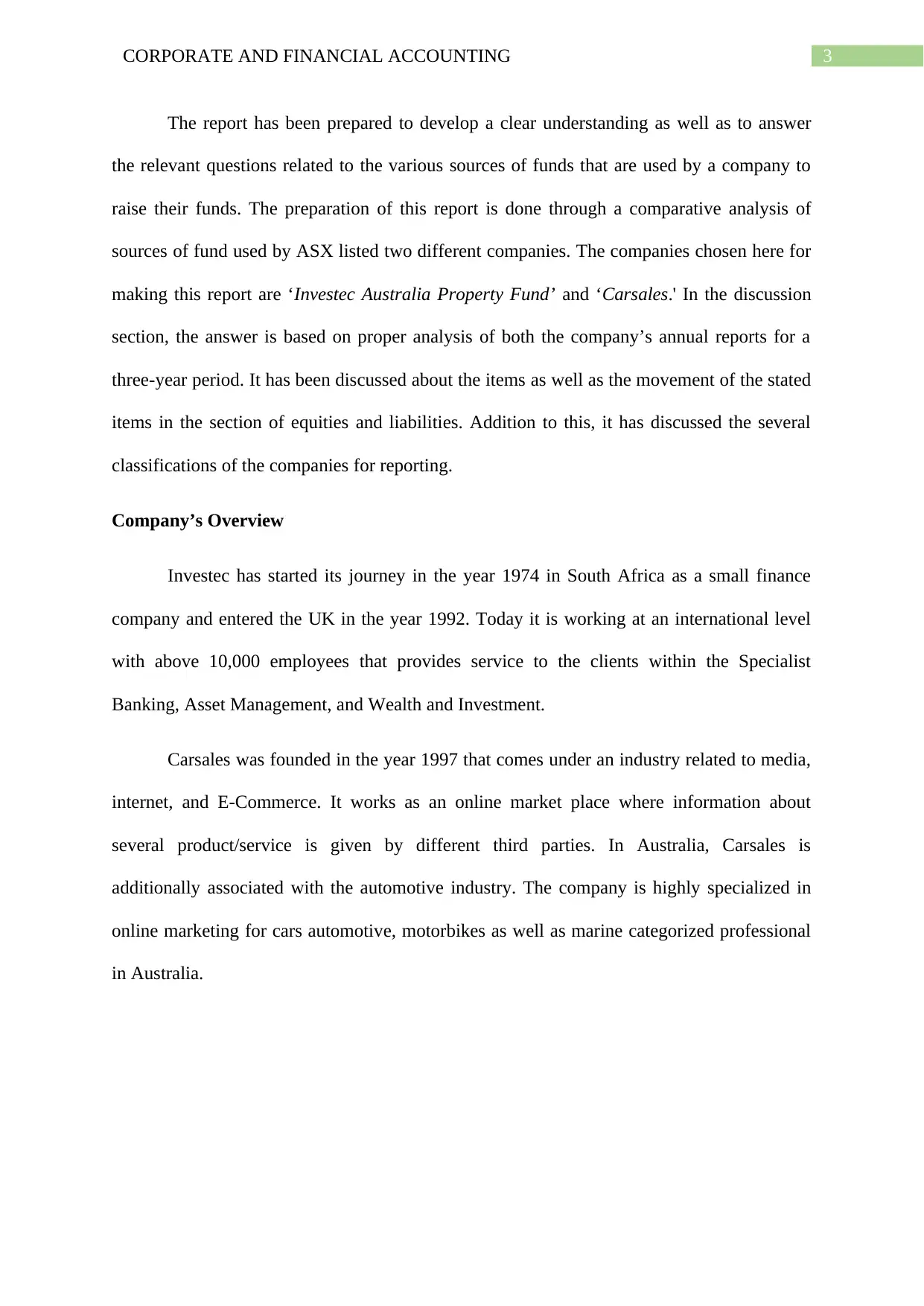
3CORPORATE AND FINANCIAL ACCOUNTING
The report has been prepared to develop a clear understanding as well as to answer
the relevant questions related to the various sources of funds that are used by a company to
raise their funds. The preparation of this report is done through a comparative analysis of
sources of fund used by ASX listed two different companies. The companies chosen here for
making this report are ‘Investec Australia Property Fund’ and ‘Carsales.' In the discussion
section, the answer is based on proper analysis of both the company’s annual reports for a
three-year period. It has been discussed about the items as well as the movement of the stated
items in the section of equities and liabilities. Addition to this, it has discussed the several
classifications of the companies for reporting.
Company’s Overview
Investec has started its journey in the year 1974 in South Africa as a small finance
company and entered the UK in the year 1992. Today it is working at an international level
with above 10,000 employees that provides service to the clients within the Specialist
Banking, Asset Management, and Wealth and Investment.
Carsales was founded in the year 1997 that comes under an industry related to media,
internet, and E-Commerce. It works as an online market place where information about
several product/service is given by different third parties. In Australia, Carsales is
additionally associated with the automotive industry. The company is highly specialized in
online marketing for cars automotive, motorbikes as well as marine categorized professional
in Australia.
The report has been prepared to develop a clear understanding as well as to answer
the relevant questions related to the various sources of funds that are used by a company to
raise their funds. The preparation of this report is done through a comparative analysis of
sources of fund used by ASX listed two different companies. The companies chosen here for
making this report are ‘Investec Australia Property Fund’ and ‘Carsales.' In the discussion
section, the answer is based on proper analysis of both the company’s annual reports for a
three-year period. It has been discussed about the items as well as the movement of the stated
items in the section of equities and liabilities. Addition to this, it has discussed the several
classifications of the companies for reporting.
Company’s Overview
Investec has started its journey in the year 1974 in South Africa as a small finance
company and entered the UK in the year 1992. Today it is working at an international level
with above 10,000 employees that provides service to the clients within the Specialist
Banking, Asset Management, and Wealth and Investment.
Carsales was founded in the year 1997 that comes under an industry related to media,
internet, and E-Commerce. It works as an online market place where information about
several product/service is given by different third parties. In Australia, Carsales is
additionally associated with the automotive industry. The company is highly specialized in
online marketing for cars automotive, motorbikes as well as marine categorized professional
in Australia.
Paraphrase This Document
Need a fresh take? Get an instant paraphrase of this document with our AI Paraphraser
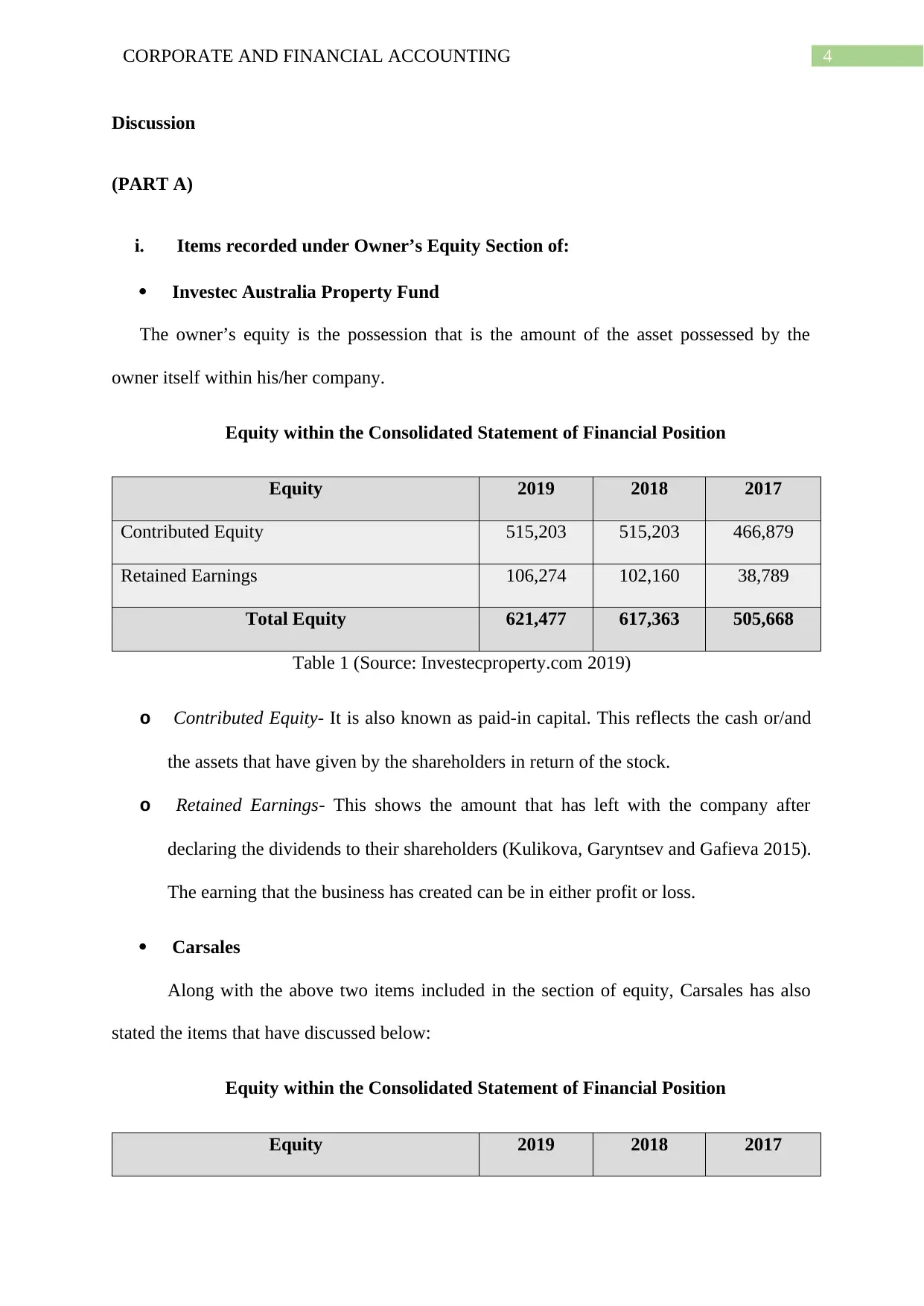
4CORPORATE AND FINANCIAL ACCOUNTING
Discussion
(PART A)
i. Items recorded under Owner’s Equity Section of:
Investec Australia Property Fund
The owner’s equity is the possession that is the amount of the asset possessed by the
owner itself within his/her company.
Equity within the Consolidated Statement of Financial Position
Equity 2019 2018 2017
Contributed Equity 515,203 515,203 466,879
Retained Earnings 106,274 102,160 38,789
Total Equity 621,477 617,363 505,668
Table 1 (Source: Investecproperty.com 2019)
o Contributed Equity- It is also known as paid-in capital. This reflects the cash or/and
the assets that have given by the shareholders in return of the stock.
o Retained Earnings- This shows the amount that has left with the company after
declaring the dividends to their shareholders (Kulikova, Garyntsev and Gafieva 2015).
The earning that the business has created can be in either profit or loss.
Carsales
Along with the above two items included in the section of equity, Carsales has also
stated the items that have discussed below:
Equity within the Consolidated Statement of Financial Position
Equity 2019 2018 2017
Discussion
(PART A)
i. Items recorded under Owner’s Equity Section of:
Investec Australia Property Fund
The owner’s equity is the possession that is the amount of the asset possessed by the
owner itself within his/her company.
Equity within the Consolidated Statement of Financial Position
Equity 2019 2018 2017
Contributed Equity 515,203 515,203 466,879
Retained Earnings 106,274 102,160 38,789
Total Equity 621,477 617,363 505,668
Table 1 (Source: Investecproperty.com 2019)
o Contributed Equity- It is also known as paid-in capital. This reflects the cash or/and
the assets that have given by the shareholders in return of the stock.
o Retained Earnings- This shows the amount that has left with the company after
declaring the dividends to their shareholders (Kulikova, Garyntsev and Gafieva 2015).
The earning that the business has created can be in either profit or loss.
Carsales
Along with the above two items included in the section of equity, Carsales has also
stated the items that have discussed below:
Equity within the Consolidated Statement of Financial Position
Equity 2019 2018 2017
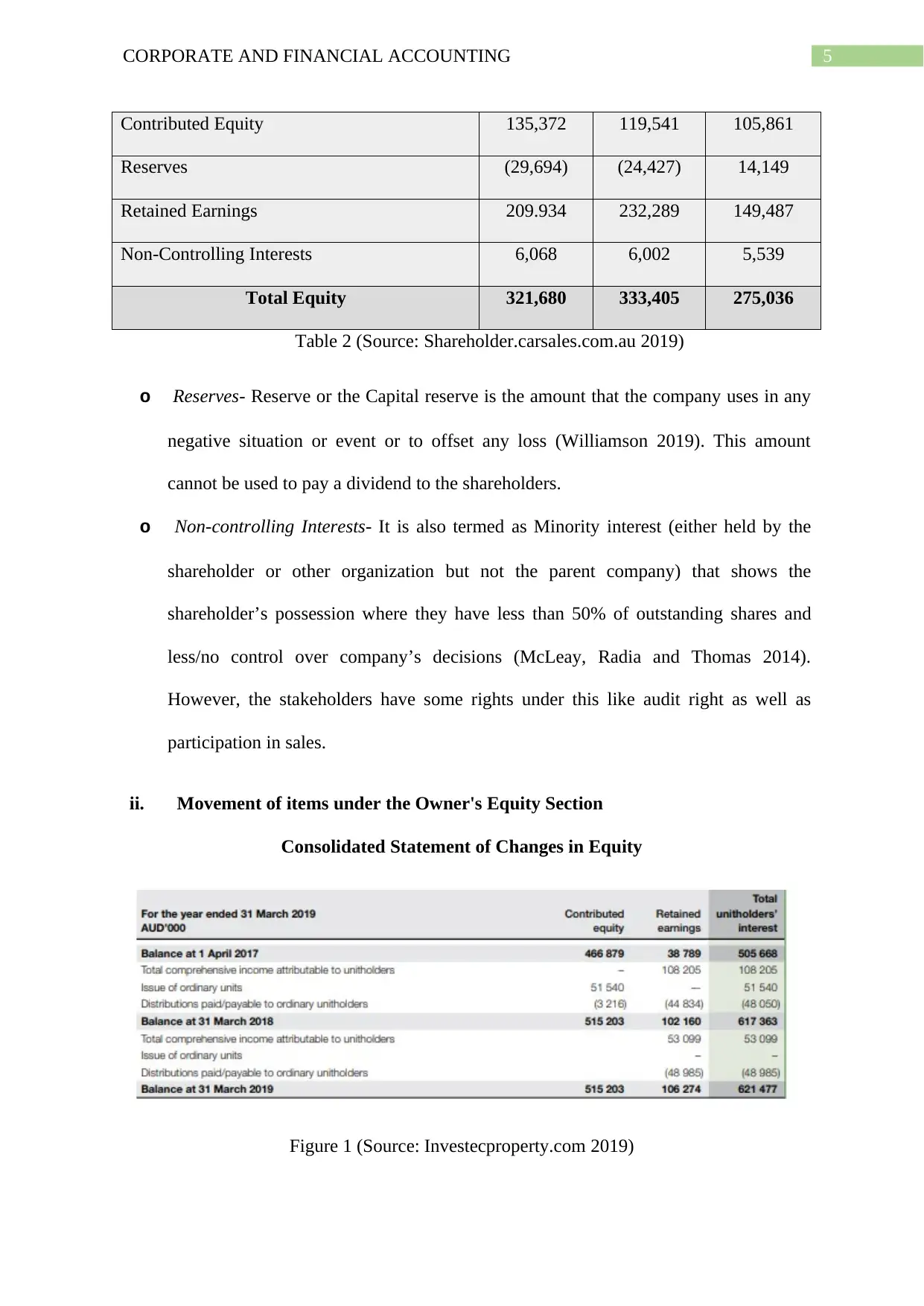
5CORPORATE AND FINANCIAL ACCOUNTING
Contributed Equity 135,372 119,541 105,861
Reserves (29,694) (24,427) 14,149
Retained Earnings 209.934 232,289 149,487
Non-Controlling Interests 6,068 6,002 5,539
Total Equity 321,680 333,405 275,036
Table 2 (Source: Shareholder.carsales.com.au 2019)
o Reserves- Reserve or the Capital reserve is the amount that the company uses in any
negative situation or event or to offset any loss (Williamson 2019). This amount
cannot be used to pay a dividend to the shareholders.
o Non-controlling Interests- It is also termed as Minority interest (either held by the
shareholder or other organization but not the parent company) that shows the
shareholder’s possession where they have less than 50% of outstanding shares and
less/no control over company’s decisions (McLeay, Radia and Thomas 2014).
However, the stakeholders have some rights under this like audit right as well as
participation in sales.
ii. Movement of items under the Owner's Equity Section
Consolidated Statement of Changes in Equity
Figure 1 (Source: Investecproperty.com 2019)
Contributed Equity 135,372 119,541 105,861
Reserves (29,694) (24,427) 14,149
Retained Earnings 209.934 232,289 149,487
Non-Controlling Interests 6,068 6,002 5,539
Total Equity 321,680 333,405 275,036
Table 2 (Source: Shareholder.carsales.com.au 2019)
o Reserves- Reserve or the Capital reserve is the amount that the company uses in any
negative situation or event or to offset any loss (Williamson 2019). This amount
cannot be used to pay a dividend to the shareholders.
o Non-controlling Interests- It is also termed as Minority interest (either held by the
shareholder or other organization but not the parent company) that shows the
shareholder’s possession where they have less than 50% of outstanding shares and
less/no control over company’s decisions (McLeay, Radia and Thomas 2014).
However, the stakeholders have some rights under this like audit right as well as
participation in sales.
ii. Movement of items under the Owner's Equity Section
Consolidated Statement of Changes in Equity
Figure 1 (Source: Investecproperty.com 2019)
⊘ This is a preview!⊘
Do you want full access?
Subscribe today to unlock all pages.

Trusted by 1+ million students worldwide
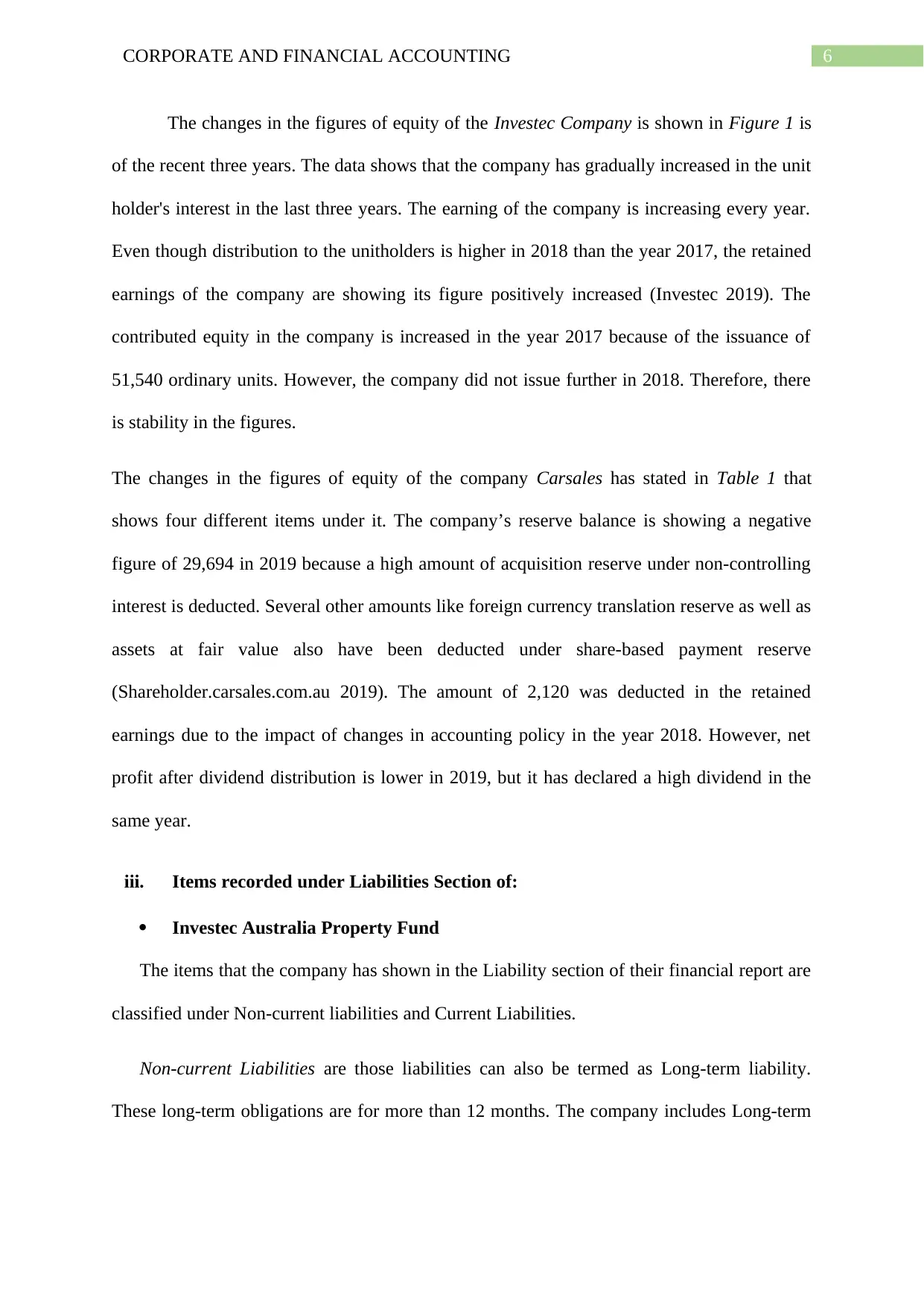
6CORPORATE AND FINANCIAL ACCOUNTING
The changes in the figures of equity of the Investec Company is shown in Figure 1 is
of the recent three years. The data shows that the company has gradually increased in the unit
holder's interest in the last three years. The earning of the company is increasing every year.
Even though distribution to the unitholders is higher in 2018 than the year 2017, the retained
earnings of the company are showing its figure positively increased (Investec 2019). The
contributed equity in the company is increased in the year 2017 because of the issuance of
51,540 ordinary units. However, the company did not issue further in 2018. Therefore, there
is stability in the figures.
The changes in the figures of equity of the company Carsales has stated in Table 1 that
shows four different items under it. The company’s reserve balance is showing a negative
figure of 29,694 in 2019 because a high amount of acquisition reserve under non-controlling
interest is deducted. Several other amounts like foreign currency translation reserve as well as
assets at fair value also have been deducted under share-based payment reserve
(Shareholder.carsales.com.au 2019). The amount of 2,120 was deducted in the retained
earnings due to the impact of changes in accounting policy in the year 2018. However, net
profit after dividend distribution is lower in 2019, but it has declared a high dividend in the
same year.
iii. Items recorded under Liabilities Section of:
Investec Australia Property Fund
The items that the company has shown in the Liability section of their financial report are
classified under Non-current liabilities and Current Liabilities.
Non-current Liabilities are those liabilities can also be termed as Long-term liability.
These long-term obligations are for more than 12 months. The company includes Long-term
The changes in the figures of equity of the Investec Company is shown in Figure 1 is
of the recent three years. The data shows that the company has gradually increased in the unit
holder's interest in the last three years. The earning of the company is increasing every year.
Even though distribution to the unitholders is higher in 2018 than the year 2017, the retained
earnings of the company are showing its figure positively increased (Investec 2019). The
contributed equity in the company is increased in the year 2017 because of the issuance of
51,540 ordinary units. However, the company did not issue further in 2018. Therefore, there
is stability in the figures.
The changes in the figures of equity of the company Carsales has stated in Table 1 that
shows four different items under it. The company’s reserve balance is showing a negative
figure of 29,694 in 2019 because a high amount of acquisition reserve under non-controlling
interest is deducted. Several other amounts like foreign currency translation reserve as well as
assets at fair value also have been deducted under share-based payment reserve
(Shareholder.carsales.com.au 2019). The amount of 2,120 was deducted in the retained
earnings due to the impact of changes in accounting policy in the year 2018. However, net
profit after dividend distribution is lower in 2019, but it has declared a high dividend in the
same year.
iii. Items recorded under Liabilities Section of:
Investec Australia Property Fund
The items that the company has shown in the Liability section of their financial report are
classified under Non-current liabilities and Current Liabilities.
Non-current Liabilities are those liabilities can also be termed as Long-term liability.
These long-term obligations are for more than 12 months. The company includes Long-term
Paraphrase This Document
Need a fresh take? Get an instant paraphrase of this document with our AI Paraphraser
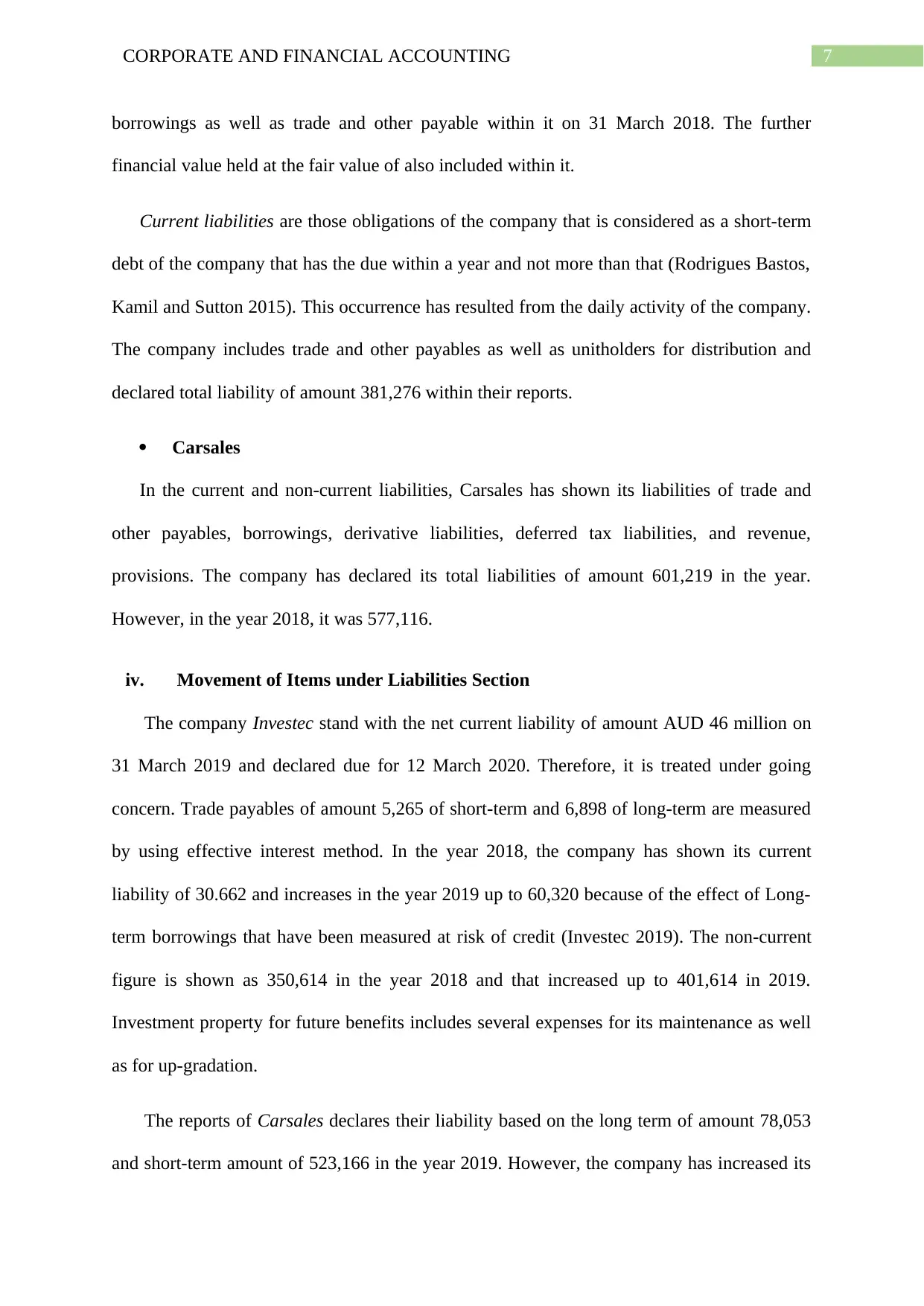
7CORPORATE AND FINANCIAL ACCOUNTING
borrowings as well as trade and other payable within it on 31 March 2018. The further
financial value held at the fair value of also included within it.
Current liabilities are those obligations of the company that is considered as a short-term
debt of the company that has the due within a year and not more than that (Rodrigues Bastos,
Kamil and Sutton 2015). This occurrence has resulted from the daily activity of the company.
The company includes trade and other payables as well as unitholders for distribution and
declared total liability of amount 381,276 within their reports.
Carsales
In the current and non-current liabilities, Carsales has shown its liabilities of trade and
other payables, borrowings, derivative liabilities, deferred tax liabilities, and revenue,
provisions. The company has declared its total liabilities of amount 601,219 in the year.
However, in the year 2018, it was 577,116.
iv. Movement of Items under Liabilities Section
The company Investec stand with the net current liability of amount AUD 46 million on
31 March 2019 and declared due for 12 March 2020. Therefore, it is treated under going
concern. Trade payables of amount 5,265 of short-term and 6,898 of long-term are measured
by using effective interest method. In the year 2018, the company has shown its current
liability of 30.662 and increases in the year 2019 up to 60,320 because of the effect of Long-
term borrowings that have been measured at risk of credit (Investec 2019). The non-current
figure is shown as 350,614 in the year 2018 and that increased up to 401,614 in 2019.
Investment property for future benefits includes several expenses for its maintenance as well
as for up-gradation.
The reports of Carsales declares their liability based on the long term of amount 78,053
and short-term amount of 523,166 in the year 2019. However, the company has increased its
borrowings as well as trade and other payable within it on 31 March 2018. The further
financial value held at the fair value of also included within it.
Current liabilities are those obligations of the company that is considered as a short-term
debt of the company that has the due within a year and not more than that (Rodrigues Bastos,
Kamil and Sutton 2015). This occurrence has resulted from the daily activity of the company.
The company includes trade and other payables as well as unitholders for distribution and
declared total liability of amount 381,276 within their reports.
Carsales
In the current and non-current liabilities, Carsales has shown its liabilities of trade and
other payables, borrowings, derivative liabilities, deferred tax liabilities, and revenue,
provisions. The company has declared its total liabilities of amount 601,219 in the year.
However, in the year 2018, it was 577,116.
iv. Movement of Items under Liabilities Section
The company Investec stand with the net current liability of amount AUD 46 million on
31 March 2019 and declared due for 12 March 2020. Therefore, it is treated under going
concern. Trade payables of amount 5,265 of short-term and 6,898 of long-term are measured
by using effective interest method. In the year 2018, the company has shown its current
liability of 30.662 and increases in the year 2019 up to 60,320 because of the effect of Long-
term borrowings that have been measured at risk of credit (Investec 2019). The non-current
figure is shown as 350,614 in the year 2018 and that increased up to 401,614 in 2019.
Investment property for future benefits includes several expenses for its maintenance as well
as for up-gradation.
The reports of Carsales declares their liability based on the long term of amount 78,053
and short-term amount of 523,166 in the year 2019. However, the company has increased its
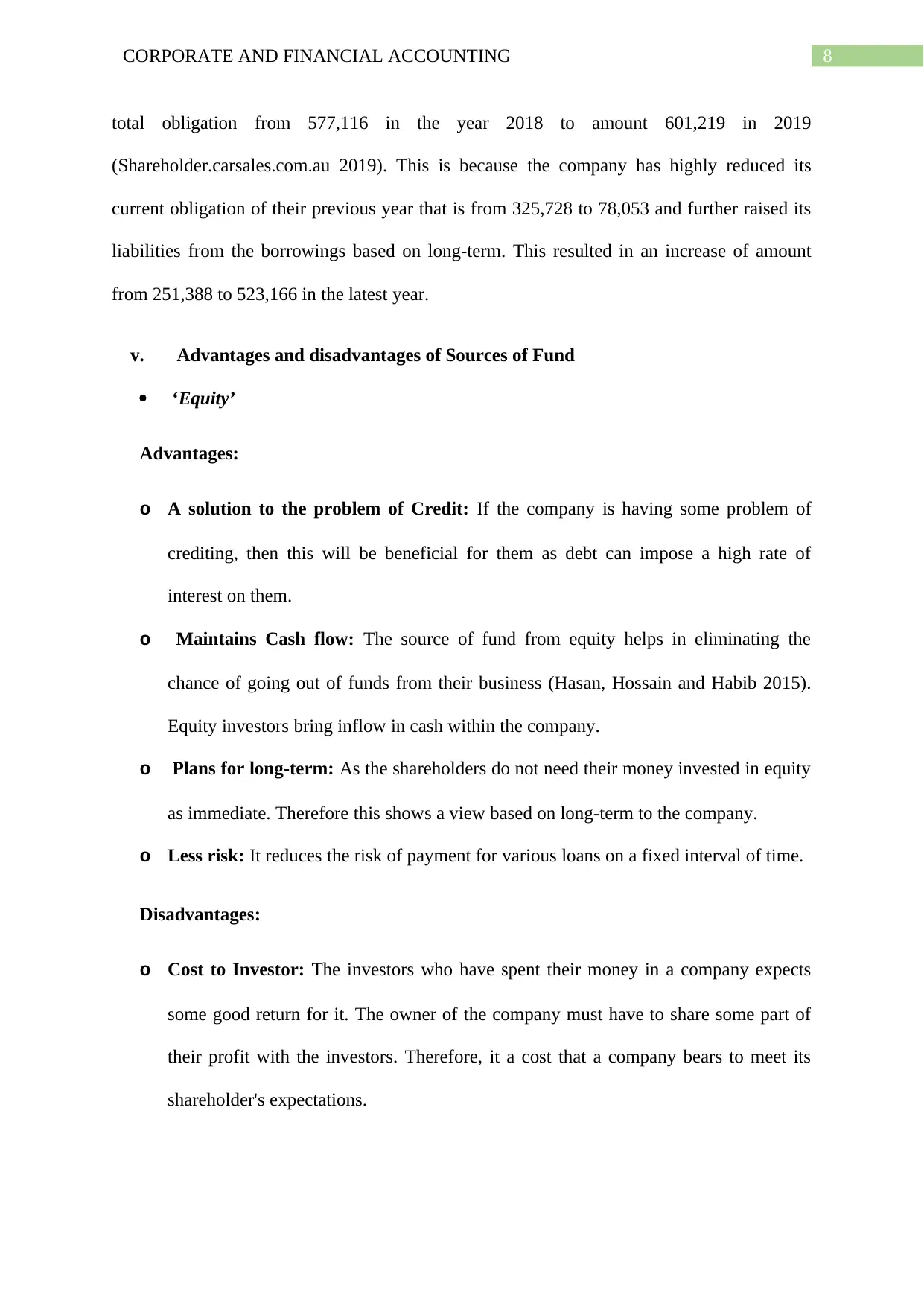
8CORPORATE AND FINANCIAL ACCOUNTING
total obligation from 577,116 in the year 2018 to amount 601,219 in 2019
(Shareholder.carsales.com.au 2019). This is because the company has highly reduced its
current obligation of their previous year that is from 325,728 to 78,053 and further raised its
liabilities from the borrowings based on long-term. This resulted in an increase of amount
from 251,388 to 523,166 in the latest year.
v. Advantages and disadvantages of Sources of Fund
‘Equity’
Advantages:
o A solution to the problem of Credit: If the company is having some problem of
crediting, then this will be beneficial for them as debt can impose a high rate of
interest on them.
o Maintains Cash flow: The source of fund from equity helps in eliminating the
chance of going out of funds from their business (Hasan, Hossain and Habib 2015).
Equity investors bring inflow in cash within the company.
o Plans for long-term: As the shareholders do not need their money invested in equity
as immediate. Therefore this shows a view based on long-term to the company.
o Less risk: It reduces the risk of payment for various loans on a fixed interval of time.
Disadvantages:
o Cost to Investor: The investors who have spent their money in a company expects
some good return for it. The owner of the company must have to share some part of
their profit with the investors. Therefore, it a cost that a company bears to meet its
shareholder's expectations.
total obligation from 577,116 in the year 2018 to amount 601,219 in 2019
(Shareholder.carsales.com.au 2019). This is because the company has highly reduced its
current obligation of their previous year that is from 325,728 to 78,053 and further raised its
liabilities from the borrowings based on long-term. This resulted in an increase of amount
from 251,388 to 523,166 in the latest year.
v. Advantages and disadvantages of Sources of Fund
‘Equity’
Advantages:
o A solution to the problem of Credit: If the company is having some problem of
crediting, then this will be beneficial for them as debt can impose a high rate of
interest on them.
o Maintains Cash flow: The source of fund from equity helps in eliminating the
chance of going out of funds from their business (Hasan, Hossain and Habib 2015).
Equity investors bring inflow in cash within the company.
o Plans for long-term: As the shareholders do not need their money invested in equity
as immediate. Therefore this shows a view based on long-term to the company.
o Less risk: It reduces the risk of payment for various loans on a fixed interval of time.
Disadvantages:
o Cost to Investor: The investors who have spent their money in a company expects
some good return for it. The owner of the company must have to share some part of
their profit with the investors. Therefore, it a cost that a company bears to meet its
shareholder's expectations.
⊘ This is a preview!⊘
Do you want full access?
Subscribe today to unlock all pages.

Trusted by 1+ million students worldwide
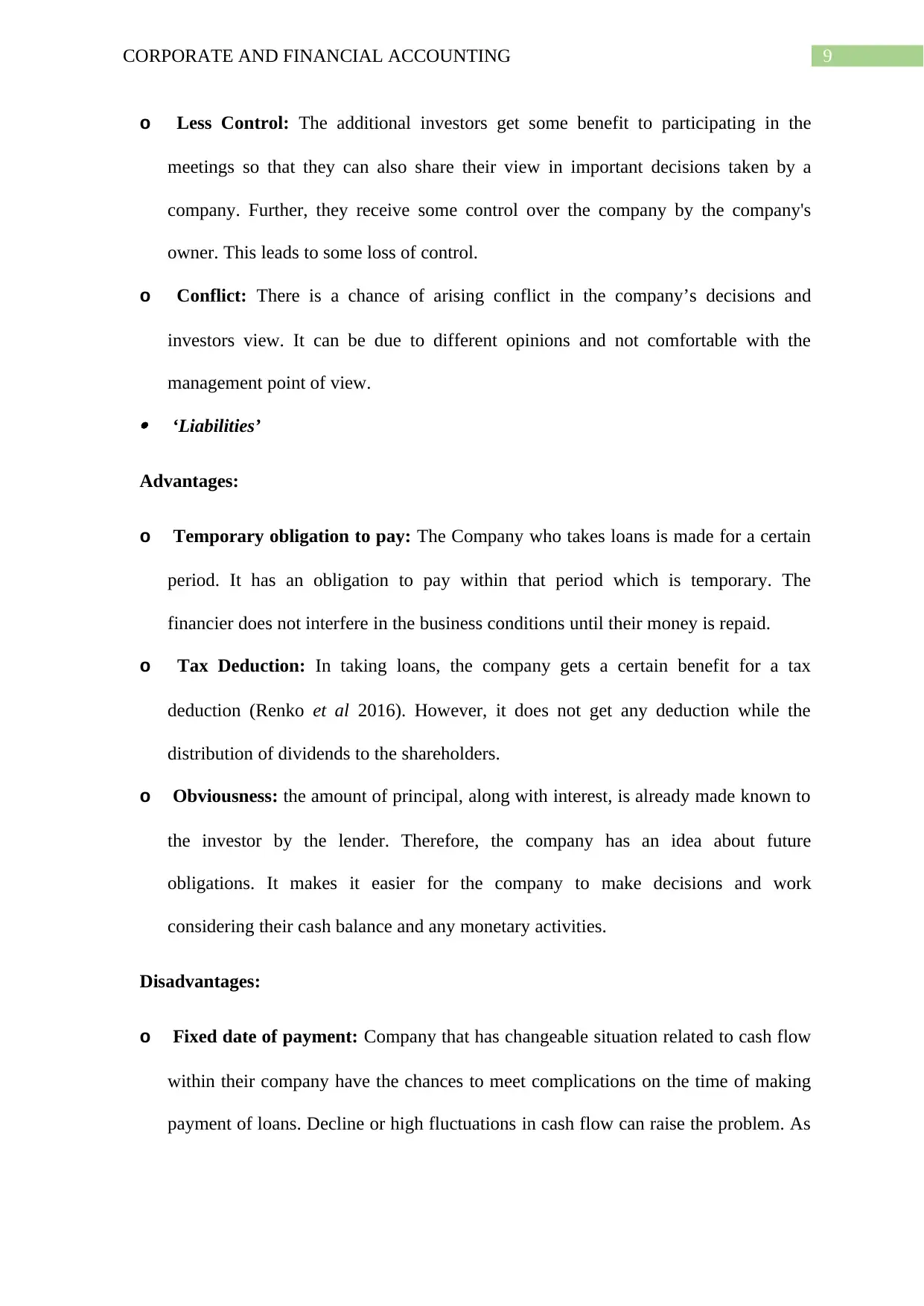
9CORPORATE AND FINANCIAL ACCOUNTING
o Less Control: The additional investors get some benefit to participating in the
meetings so that they can also share their view in important decisions taken by a
company. Further, they receive some control over the company by the company's
owner. This leads to some loss of control.
o Conflict: There is a chance of arising conflict in the company’s decisions and
investors view. It can be due to different opinions and not comfortable with the
management point of view. ‘Liabilities’
Advantages:
o Temporary obligation to pay: The Company who takes loans is made for a certain
period. It has an obligation to pay within that period which is temporary. The
financier does not interfere in the business conditions until their money is repaid.
o Tax Deduction: In taking loans, the company gets a certain benefit for a tax
deduction (Renko et al 2016). However, it does not get any deduction while the
distribution of dividends to the shareholders.
o Obviousness: the amount of principal, along with interest, is already made known to
the investor by the lender. Therefore, the company has an idea about future
obligations. It makes it easier for the company to make decisions and work
considering their cash balance and any monetary activities.
Disadvantages:
o Fixed date of payment: Company that has changeable situation related to cash flow
within their company have the chances to meet complications on the time of making
payment of loans. Decline or high fluctuations in cash flow can raise the problem. As
o Less Control: The additional investors get some benefit to participating in the
meetings so that they can also share their view in important decisions taken by a
company. Further, they receive some control over the company by the company's
owner. This leads to some loss of control.
o Conflict: There is a chance of arising conflict in the company’s decisions and
investors view. It can be due to different opinions and not comfortable with the
management point of view. ‘Liabilities’
Advantages:
o Temporary obligation to pay: The Company who takes loans is made for a certain
period. It has an obligation to pay within that period which is temporary. The
financier does not interfere in the business conditions until their money is repaid.
o Tax Deduction: In taking loans, the company gets a certain benefit for a tax
deduction (Renko et al 2016). However, it does not get any deduction while the
distribution of dividends to the shareholders.
o Obviousness: the amount of principal, along with interest, is already made known to
the investor by the lender. Therefore, the company has an idea about future
obligations. It makes it easier for the company to make decisions and work
considering their cash balance and any monetary activities.
Disadvantages:
o Fixed date of payment: Company that has changeable situation related to cash flow
within their company have the chances to meet complications on the time of making
payment of loans. Decline or high fluctuations in cash flow can raise the problem. As
Paraphrase This Document
Need a fresh take? Get an instant paraphrase of this document with our AI Paraphraser
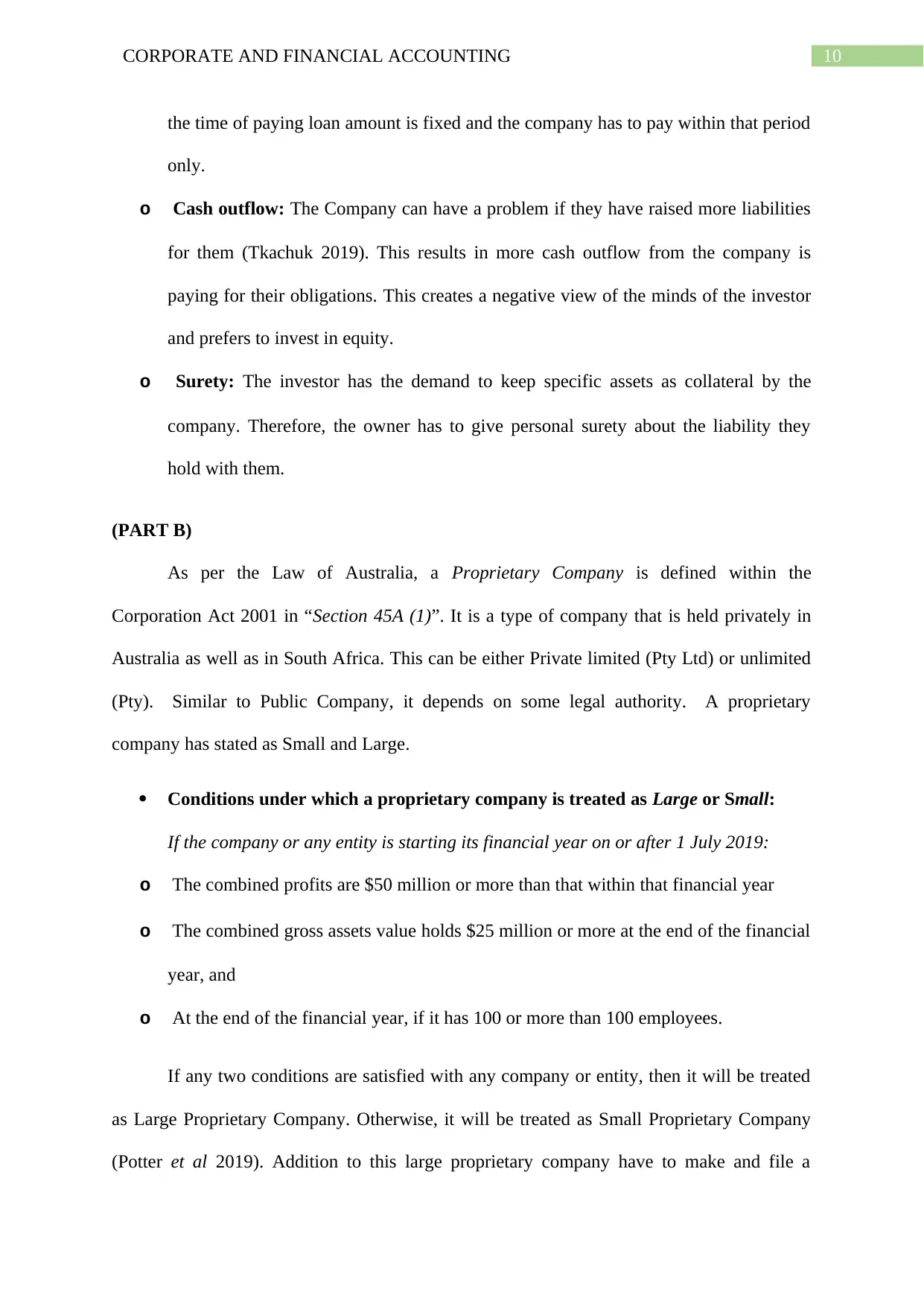
10CORPORATE AND FINANCIAL ACCOUNTING
the time of paying loan amount is fixed and the company has to pay within that period
only.
o Cash outflow: The Company can have a problem if they have raised more liabilities
for them (Tkachuk 2019). This results in more cash outflow from the company is
paying for their obligations. This creates a negative view of the minds of the investor
and prefers to invest in equity.
o Surety: The investor has the demand to keep specific assets as collateral by the
company. Therefore, the owner has to give personal surety about the liability they
hold with them.
(PART B)
As per the Law of Australia, a Proprietary Company is defined within the
Corporation Act 2001 in “Section 45A (1)”. It is a type of company that is held privately in
Australia as well as in South Africa. This can be either Private limited (Pty Ltd) or unlimited
(Pty). Similar to Public Company, it depends on some legal authority. A proprietary
company has stated as Small and Large.
Conditions under which a proprietary company is treated as Large or Small:
If the company or any entity is starting its financial year on or after 1 July 2019:
o The combined profits are $50 million or more than that within that financial year
o The combined gross assets value holds $25 million or more at the end of the financial
year, and
o At the end of the financial year, if it has 100 or more than 100 employees.
If any two conditions are satisfied with any company or entity, then it will be treated
as Large Proprietary Company. Otherwise, it will be treated as Small Proprietary Company
(Potter et al 2019). Addition to this large proprietary company have to make and file a
the time of paying loan amount is fixed and the company has to pay within that period
only.
o Cash outflow: The Company can have a problem if they have raised more liabilities
for them (Tkachuk 2019). This results in more cash outflow from the company is
paying for their obligations. This creates a negative view of the minds of the investor
and prefers to invest in equity.
o Surety: The investor has the demand to keep specific assets as collateral by the
company. Therefore, the owner has to give personal surety about the liability they
hold with them.
(PART B)
As per the Law of Australia, a Proprietary Company is defined within the
Corporation Act 2001 in “Section 45A (1)”. It is a type of company that is held privately in
Australia as well as in South Africa. This can be either Private limited (Pty Ltd) or unlimited
(Pty). Similar to Public Company, it depends on some legal authority. A proprietary
company has stated as Small and Large.
Conditions under which a proprietary company is treated as Large or Small:
If the company or any entity is starting its financial year on or after 1 July 2019:
o The combined profits are $50 million or more than that within that financial year
o The combined gross assets value holds $25 million or more at the end of the financial
year, and
o At the end of the financial year, if it has 100 or more than 100 employees.
If any two conditions are satisfied with any company or entity, then it will be treated
as Large Proprietary Company. Otherwise, it will be treated as Small Proprietary Company
(Potter et al 2019). Addition to this large proprietary company have to make and file a
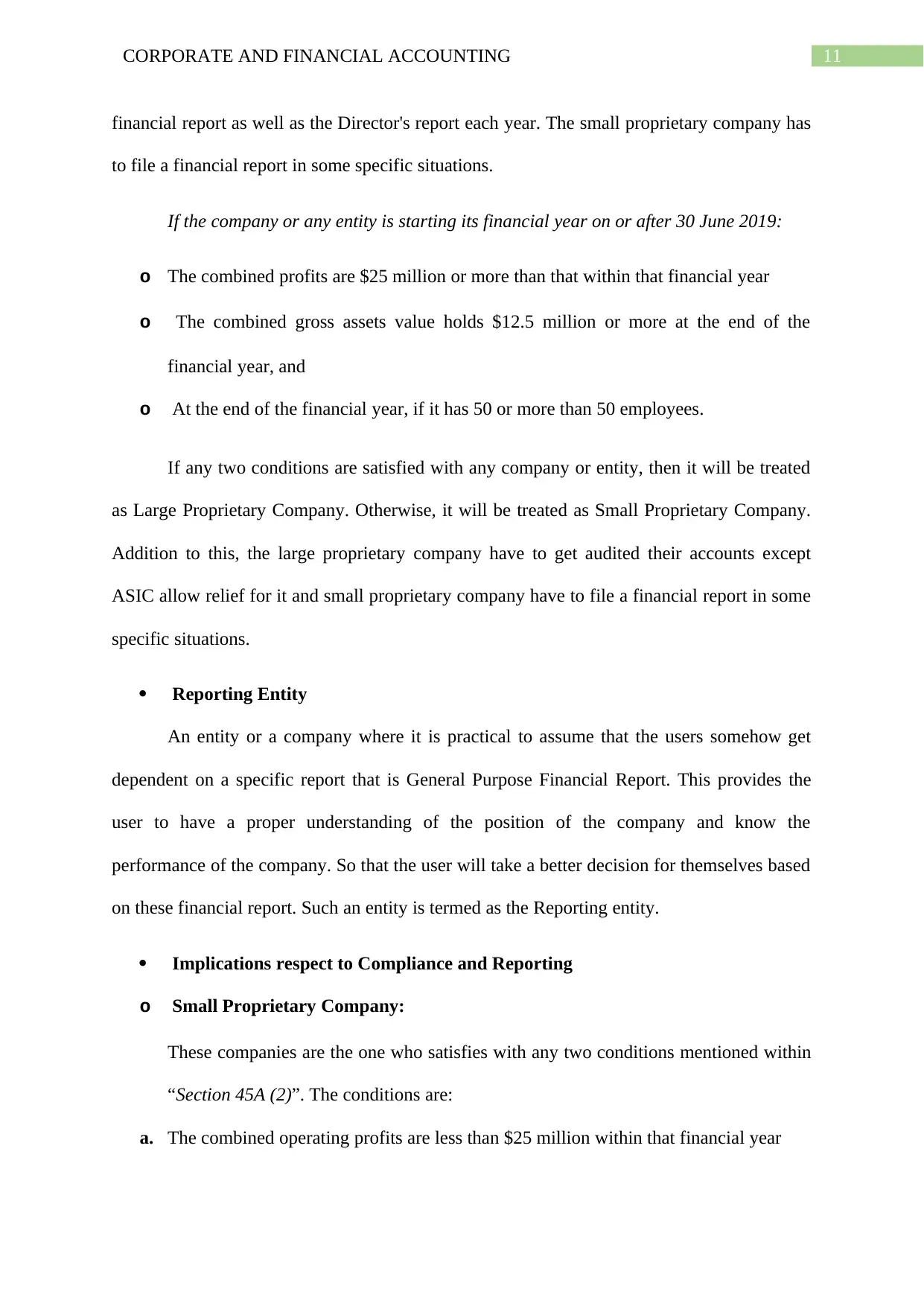
11CORPORATE AND FINANCIAL ACCOUNTING
financial report as well as the Director's report each year. The small proprietary company has
to file a financial report in some specific situations.
If the company or any entity is starting its financial year on or after 30 June 2019:
o The combined profits are $25 million or more than that within that financial year
o The combined gross assets value holds $12.5 million or more at the end of the
financial year, and
o At the end of the financial year, if it has 50 or more than 50 employees.
If any two conditions are satisfied with any company or entity, then it will be treated
as Large Proprietary Company. Otherwise, it will be treated as Small Proprietary Company.
Addition to this, the large proprietary company have to get audited their accounts except
ASIC allow relief for it and small proprietary company have to file a financial report in some
specific situations.
Reporting Entity
An entity or a company where it is practical to assume that the users somehow get
dependent on a specific report that is General Purpose Financial Report. This provides the
user to have a proper understanding of the position of the company and know the
performance of the company. So that the user will take a better decision for themselves based
on these financial report. Such an entity is termed as the Reporting entity.
Implications respect to Compliance and Reporting
o Small Proprietary Company:
These companies are the one who satisfies with any two conditions mentioned within
“Section 45A (2)”. The conditions are:
a. The combined operating profits are less than $25 million within that financial year
financial report as well as the Director's report each year. The small proprietary company has
to file a financial report in some specific situations.
If the company or any entity is starting its financial year on or after 30 June 2019:
o The combined profits are $25 million or more than that within that financial year
o The combined gross assets value holds $12.5 million or more at the end of the
financial year, and
o At the end of the financial year, if it has 50 or more than 50 employees.
If any two conditions are satisfied with any company or entity, then it will be treated
as Large Proprietary Company. Otherwise, it will be treated as Small Proprietary Company.
Addition to this, the large proprietary company have to get audited their accounts except
ASIC allow relief for it and small proprietary company have to file a financial report in some
specific situations.
Reporting Entity
An entity or a company where it is practical to assume that the users somehow get
dependent on a specific report that is General Purpose Financial Report. This provides the
user to have a proper understanding of the position of the company and know the
performance of the company. So that the user will take a better decision for themselves based
on these financial report. Such an entity is termed as the Reporting entity.
Implications respect to Compliance and Reporting
o Small Proprietary Company:
These companies are the one who satisfies with any two conditions mentioned within
“Section 45A (2)”. The conditions are:
a. The combined operating profits are less than $25 million within that financial year
⊘ This is a preview!⊘
Do you want full access?
Subscribe today to unlock all pages.

Trusted by 1+ million students worldwide
1 out of 17
Related Documents
Your All-in-One AI-Powered Toolkit for Academic Success.
+13062052269
info@desklib.com
Available 24*7 on WhatsApp / Email
![[object Object]](/_next/static/media/star-bottom.7253800d.svg)
Unlock your academic potential
Copyright © 2020–2025 A2Z Services. All Rights Reserved. Developed and managed by ZUCOL.





